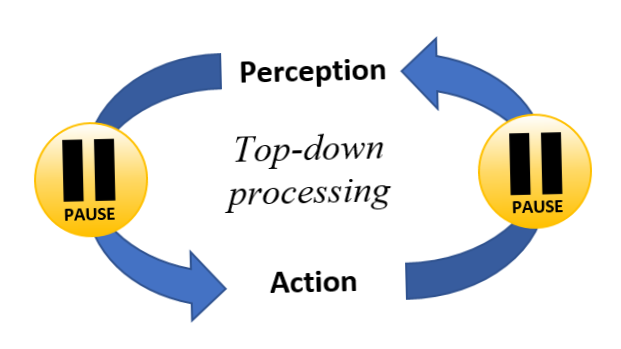Few people have sharp brains while few have slower. Not everyone is called smart not everyone is called dumb? Why? The brain is too complicated to be understood. Some have very quick functioning of the brain, all thanks to top-down processing psychology. While few are slower but needless to say, every human being is precious, whether smart or not, quick functioning or slow. Human psychology is something that is researched every day—the behaviour changes according to the patterns. Top-Down Processing progresses like that, reading the patterns from the past from the vast database of the brain. Studying, analysing, breaking down further a certain scenario is obtained to be used.
What exactly is Top-Down Processing?
In top-down processing, perceptions are formed generally by studying the patterns and surroundings and then move toward the more specific scenario out of all of them. These perceptions are highly influenced by our expectations and the knowledge we possess. The human brain is the smartest organ that knows how to fill in the blanks and anticipate the next course of action.
Top-down processing psychology is the psyche that our brains form after an idea of a big picture first from past databases of knowledge and then breaks it down into more specific information. We form a perception based on our past experiences, expectations, and emotions and then form our opinions.
Seven best Examples of Top-Down Processing effects:
Experts say that the eye does take in a lot of stimuli. Most of it is lost by the time it reaches the brain. So with the little that reaches the brain, one cannot form an entire perception of what will happen or what has happened, but here the brain knows how to fill in the blanks. The last experiences and information have been set up, and the brain is quick to form an opinion too quickly.
Here are some examples of Top-Down Processing:
Example 1: You are reading alphabets to your child, A B C D, and then you pronounce an E. But there were only four letters on the page of the book, and you reading out the 5th was out of stimuli. You have been thoroughly invested in reading out English Alphabet, and from experience, your brain knows right after D comes E even though there was no mention of Aeon on that particular page. Your brain has already perceived an opinion from past experiences.
Example 2: Have you ever read out a wrongly written sentence as correct?
Like it is written “have you gone to school”, but you instantly read it as “have you gone to school”. Yes, this happens because your brain is accustomed to reading and differentiating between correct and wrong sentences right from childhood. Hence it becomes easy for you to even spell wrong words in the right way automatically.
Example 3: Have you ever seen a picture and formed a detailed analysis?
Like there is a picture of a boy playing, and a few balls and a bat are lying far away and a field too at the backside. You automatically know that the boy is playing cricket on the field. How?? Because that’s what the information from the past has formed an opinion for you. It might be just that the boy is standing there while others are playing, but no, your brain just formed an opinion that might be biased too.
Example 4:
There are different colours and different shades to it. But how do you know the exact colour and shade of it? Thanks to the top-down processing and your past affair with colours, you already know which colour and shade are without even reading the label.
Example 5: Phonemic Restoration is an idea of what will happen next or what to fill up with. For example, you are speaking about a topic to your colleagues, and you know exactly what to say next and then again continuing like that. It is very important for human beings. Without this, humans won’t even function. Brain do know what to fill up in the blanks next and whatnot. Everything one hears, sees, and feels is captured in the brain, and few instances are used to form a liable opinion.
Example 6: What we see is exactly what we perceive. Suppose there is a book lying on the table, we see the book and like it, but do we know if it is torn from inside or not? Until we inspect, we won’t even know. So basically, human brains depend mostly on eyes, what we see until and unless our brain orders us to check upon.
Example 7: Someone is discussing an issue with you, and often, you would notice you haven’t been in a situation like this ever. But still, your brain has formed an opinion, and you are about to suggest it to the other person. How?? Have you ever faced the same situation? No, then how?
So, the answer is, if not the same situation but a similar one, if not you faced it, it might be someone else’s you might have heard. Your brain has captured that and now is giving you an opinion about it.
Conclusion
Top-down processing allows us to use various patterns and past information to understand what is happening and set up an opinion quickly. Apart from the huge experiences in the past, it only takes a small amount of information which is in probability quite similar to the current situation. The examples mentioned above are just a few leads to understanding the top-down processing psychology of a human brain.

